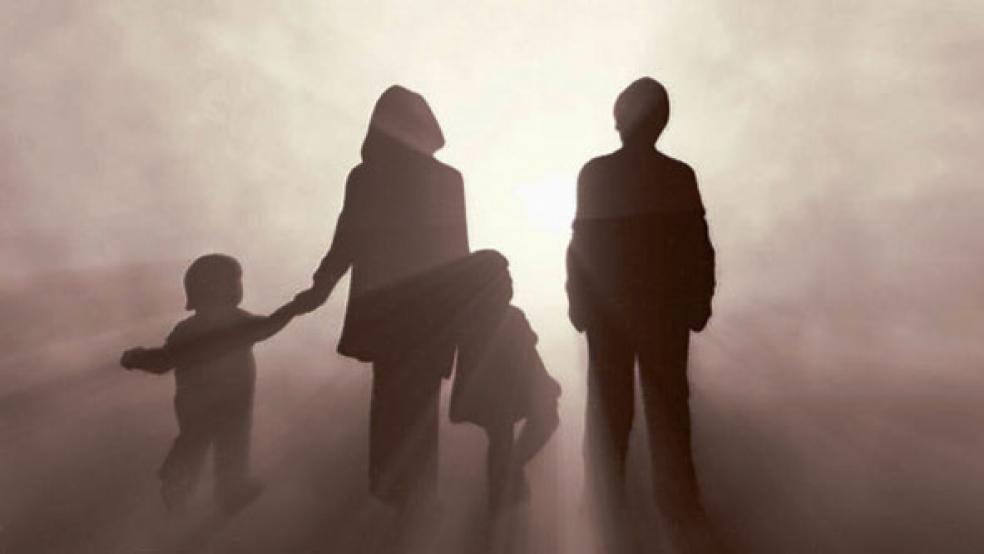After years of nail-biting economic turmoil and towering unemployment, many Americans feel they are hanging on by a thread financially, and are most fearful of sliding backwards into a lower economic stratum, according to the findings of a new survey of the attitudes of the middle class.
While at one time average families aspired to the American Dream of owning a car and house and sending their children to college, most American families now cherish achieving economic security above all else. And that means being able to hold a steady job, pay their bills on time and avoid incurring substantial debt.
The new Allstate Insurance Co./National Journal Heartland Monitor Poll released Thursday morning during a seminar on the state of the middle class found most middle class Americans enjoy less opportunity, job security and disposable income than earlier generations did.
Fifty-nine percent of the 1,000 randomly selected people interviewed said they were very concerned or somewhat concerned about falling out of their current economic class over the next few years, compared to 40 percent who said they were not concerned. As for Americans’ expectations of moving up to a higher income class at some point in their lives, 56 percent said they were hopeful while 42 percent were pessimistic. Four in ten of middle-class parents with children under the age of 18 believe their kids will be upper middle class or wealthy when they grow up.
A National Journal analysis of the survey highlighted an intriguing dichotomy: Americans retain an enduring confidence that they can better their own circumstances. Yet the results highlight how much economic anxiety and political alienation continue to overshadow daily life. Nearly half of Americans surveyed said that putting a child through college, weathering a job loss and saving enough for a comfortable retirement are realistic goals only for the very wealthy.
“I would say the big change that we see right now [is] that people, in talking about [their] middle class-ness . . . feel very much threatened,” said Ed Reilly, a global strategic communication officer for FTI Consulting, who helped conduct the poll. “And people are talking about it much more in terms of the struggle to stay in the middle class, rather than the aspiration of being able to look at that for the next generation.”
“The middle class feels like they’re living on the edge and are about to drop off,” said Tom Wilson, Chairman and CEO of Allstate Insurance Company. “The news in this poll is not good. People are hurting.”
The Heartland Monitor Poll is a quarterly survey that provides insights into the economic and political sentiments of Americans – particularly the middle class -- as they to continue to cope with the aftermath of the worst economic and financial crisis of modern times.
But simply defining the middle class has been an elusive challenge for pollsters, demographers and politicians. Sometimes it is determined as much by people’s own perceptions of their status than their income, educational attainment and social standing. Indeed, the U.S. Census Bureau does not have an official definition of the "middle class," although it does derive several measures related to the distribution of income and income inequality. In the midst of last year’s debate over extending Bush era tax cuts, President Obama effectively defined the middle class as families with a combined income below $250,000 a year.
The sense of belonging to the middle class transcended many objective economic boundaries, the National Journal analysis found. A plurality of respondents in every educational grouping said they were “middle class.” Almost two-thirds of households earning between $50,000 and $100,000 a year described themselves middle class, as did households earning as little as $30,000 to $50,000 a year and those making over $100,000 annually.
When asked to define their class status on a five-point scale, just 2 percent identified themselves as upper class and 12 percent as upper-middle class. The largest groups by far – 46 percent of respondents—described themselves as middle class.
Another important finding is that minorities are more optimistic than whites about their prospects for advancement.
Many economic studies have shown that the children of white parents -- particularly those with advanced degrees-- are far more likely than young minorities to reach the top of the economic ladder. Yet the Heartland survey results show that minorities are more likely than whites to expect opportunity for their children, in part because they are more likely to see their own lives as examples of generational success or progress. Some 70 percent of Hispanic respondents and 80 percent of African-Americans said they were likely to be in a higher class at some point in their lives, compared to only 49 percent of white respondents.
Half of all Americans in the middle class consider higher education to be the most effective way to protect and earn middle class status, according to the findings. But nearly half believe that it is only realistic for the upper class to pay for their children’s college education.
The survey also found a souring of the public’s view of President Obama and elected officials more generally since last November’s election. The share of Americans who say the country is on the right track peaked at a four year high of 41 percent in the Heartland Monitor survey shortly after the election. But that positive outlook dropped to less than three in 10 in the latest survey, which was conducted April 5 to 9.
By a margin of 41 percent to 33 percent, those interviewed said they trusted Obama over Republicans in Congress to develop economic solutions, yet 47 percent believe that Obama’s policies are making things worse for the middle class.





